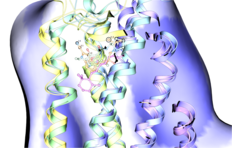Family A GPCR Modeling and Lead Compound Discovery Successes |
 Scientists at MolSoft and Schering-Plough were the first to use an homology model of a GPCR to identify new lead compounds (Cavasotto et al 2008). Six lead compounds were identified for Melanin Concentrating Hormone(MCH) receptor using ligand-based modeling and virtual screening. MCH is an obesity drug target and the ICM screening success rate is more than a 10-fold improvement over random high-throughput screening. This success built upon earlier work which showed the efficiency of ICM-Pro + VLS for GPCR modeling and screening and a demonstration of a ligand-guided method for GPCR modeling (Cavasotto et al 2004).
Scientists at MolSoft and Schering-Plough were the first to use an homology model of a GPCR to identify new lead compounds (Cavasotto et al 2008). Six lead compounds were identified for Melanin Concentrating Hormone(MCH) receptor using ligand-based modeling and virtual screening. MCH is an obesity drug target and the ICM screening success rate is more than a 10-fold improvement over random high-throughput screening. This success built upon earlier work which showed the efficiency of ICM-Pro + VLS for GPCR modeling and screening and a demonstration of a ligand-guided method for GPCR modeling (Cavasotto et al 2004).
One of the biggest challenges in GPCR modeling is understanding how the receptor changes from an inactive to an active state. Work by Katritch et al and Reynolds et al in 2009 revealed subtle changes in the GPCR binding pocket upon agonist binding. This work is key to understand how GPCR models can be used to identify new GPCR agonists.
In 2010 ICM-VLS was used to screen 4 million commercially available compounds against the crystal structure of adenosine A(2A). A selection of 56 of the best-scoring compounds were tested experimentally and 23 new receptor antagonists were discovered which is a very high success rate and highlights that the ICM-VLS method is applicable for GPCR drug design (Katritch et al 2010).
Katritch V, Jaakola VP, Lane JR, Lin J, Ijzerman AP, Yeager M, Kufareva I, Stevens RC, Abagyan R. Structure-based discovery of novel chemotypes for adenosine A(2A) receptor antagonists. J Med Chem. 2010 Feb 25;53(4):1799-809. .
Katritch V, Reynolds KA, Cherezov V, Hanson MA, Roth CB, Yeager M, Abagyan R. Analysis of full and partial agonists binding to beta2-adrenergic receptor suggests a role of transmembrane helix V in agonist-specific conformational changes. J. Mol. Recognit 2009 Aug;22(4):307-318.
Reynolds KA, Katritch V, Abagyan R. Identifying conformational changes of the beta(2) adrenoceptor that enable accurate prediction of ligand/receptor interactions and screening for GPCR modulators. J. Comput. Aided Mol. Des 2009 May;23(5):273-288.
Cavasotto CN, Orry AJ, Murgolo NJ, Czarniecki MF, Kocsi SA, Hawes BE, O'Neill KA, Hine H, Burton MS, Voigt JH, Abagyan RA, Bayne ML, Monsma FJ Jr. Discovery of Novel Chemotypes to a G-Protein-Coupled Receptor through Ligand-Steered Homology Modeling and Structure-Based Virtual Screening. J Med Chem. 2008 Feb 14;51(3):581-8.
Cavasotto, C., Orry, A.J.W., and Abagyan, R.A. Structure-Based Identification of Binding Sites, Native Ligands and Potential Inhibitors for G-Protein Coupled Receptors Proteins: Structure, Function, and Genetics 51(3), 423-433